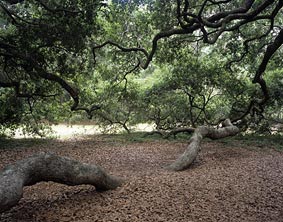
Angel Oak Park, Johns Island
Charleston, South Carolina
Angel Southern Live Oak Charleston, South Carolina
threat
The Angel Oak has withstood centuries of the furies of nature. The primary threat facing this magnificent tree today is insensitive and indiscriminate development. The Angel Oak is situated within the City of Charleston on Johns Island, a sea island that, until recent years, had been largely rural and agricultural. To date, although no development has occurred that could endanger the health and ambiance of the Angel Oak, such development is looming. Acreage adjacent to the Angel Oak is currently either wooded or agricultural. Insensitive development would most likely reduce adjacent forest cover, remove native understory growth, and introduce impervious paving. Separately or together, these changes could be catastrophic for the Angel Oak. Hydrology could be altered to an extent that groundwater available to the tree becomes scarce or too abundant. Significant alteration of drainage patterns would effect the amount of runoff water the root zone of the tree receives, an amount to which it has acclimated itself over the years.
Moreover, the Angel Oak relies heavily on the adjacent woodlands for protection from the harsh sun of the South Carolina summer. The horizontal branching pattern of Live Oak trees assures that the Angel Oak is not the tallest tree in the area. The taller trees that surround the oak deflect much of harsh sunlight, preventing sunscald. Removal of the adjacent woodland would expose the tree considerably, subjecting it to harsher weather conditions that could cause irreparable harm.
To mitigate such dramatic threats, it is important that sensitive conservation and design plans that balance and incorporate the recommendations of consulting arborists, hydrologists, and soil scientists early in the process are initiated. In doing so, local citizens and knowledgeable professionals can come together to insure the healthy preservation of the Angel Oak while accommodating appropriate development.
